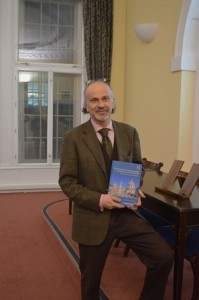
David Mayernik, Associate Professor at the University of Notre Dame School of Architecture, urban designer, architect, artist, and author, gave a talk at the London Global Gateway’s Fischer Hall on February 18. He presented the theme of emulation in Renaissance and Baroque art, and how it continues today. This is also the subject of his new book The Challenge of Emulation in Art and Architecture: Between Imitation and Invention, which was launched in London earlier this week.
In the talk entitled “The Challenge of Emulation: Learning by Rivaling”, Mayernik took the audience through the artists’ process from imitation to emulation (mastery), in order to rival other artists with their own techniques and styles, to invention, in which the artist adds his own elements and creates something new and better.
Mayernik discussed Francesco Guardi and Peter Paul Rubens amongst other artists who became great emulators of the Italian masters such as Canaletto and Michelangelo. He also talked about the stage at which an artist begins to emulate his own work in order to excel himself as in the case of Lorenzo Ghiberti. Mayernik claimed that emulation is “neither awe nor envy but respect”.
Artists, students, and Notre Dame faculty and staff attended the event. JoAnn DellaNeva, a Notre Dame professor of Renaissance Literature currently teaching in London said:
"Professor Mayernik’s talk was very accessible to non-specialists and served to remind us that imitation was a time-honored way for artists of all kinds to hone their skills, for we all have a natural inclination to learn by imitation. But, if an artist is to become great, he or she needs to do more than merely copy or reproduce a respected model: aspiring artists need to emulate their master, that is, they need to engage in a combative rivalry with that model, to outdo it in some way that can be discerned and appreciated by the viewer. Prof. Mayernik’s presentation clearly showed us many examples of us such rivalries in art and architecture of the Renaissance period and invited modern artists to engage in a similar process of emulation in their own work. Imitation in Renaissance literature is my own academic specialty so I very much appreciated the opportunity to hear about how this played out in the different media of art and architecture of the same period."
Contact: Emily Grassby, Communications and Planning Specialist for London Global Gateway, egrassby@nd.edu